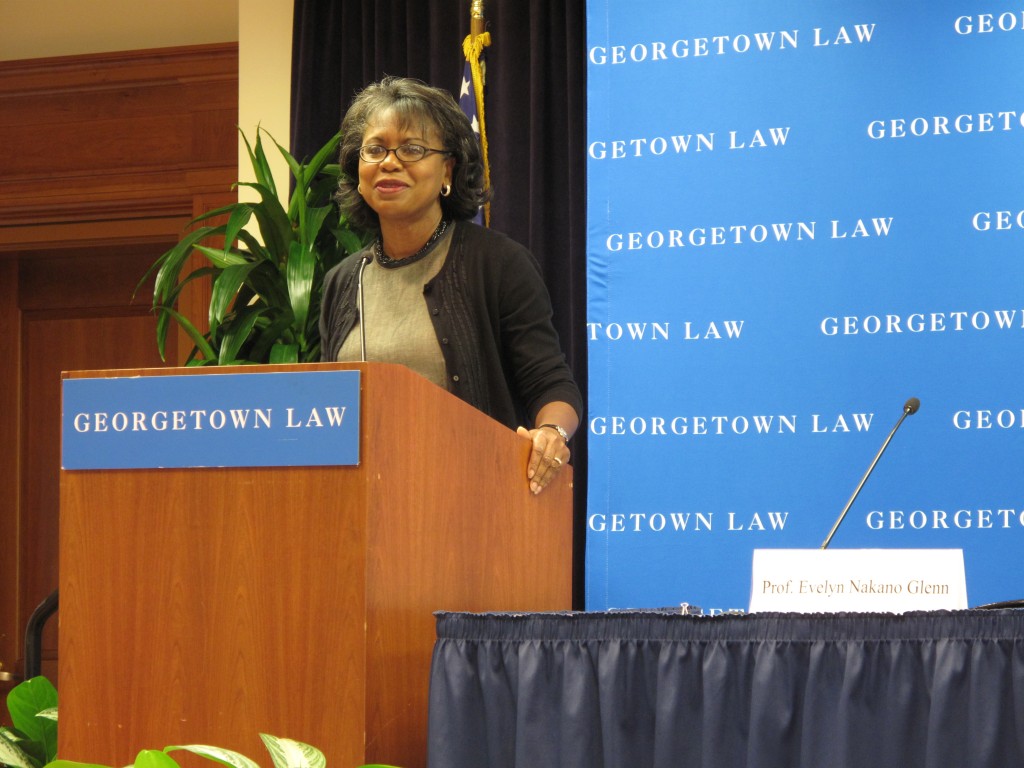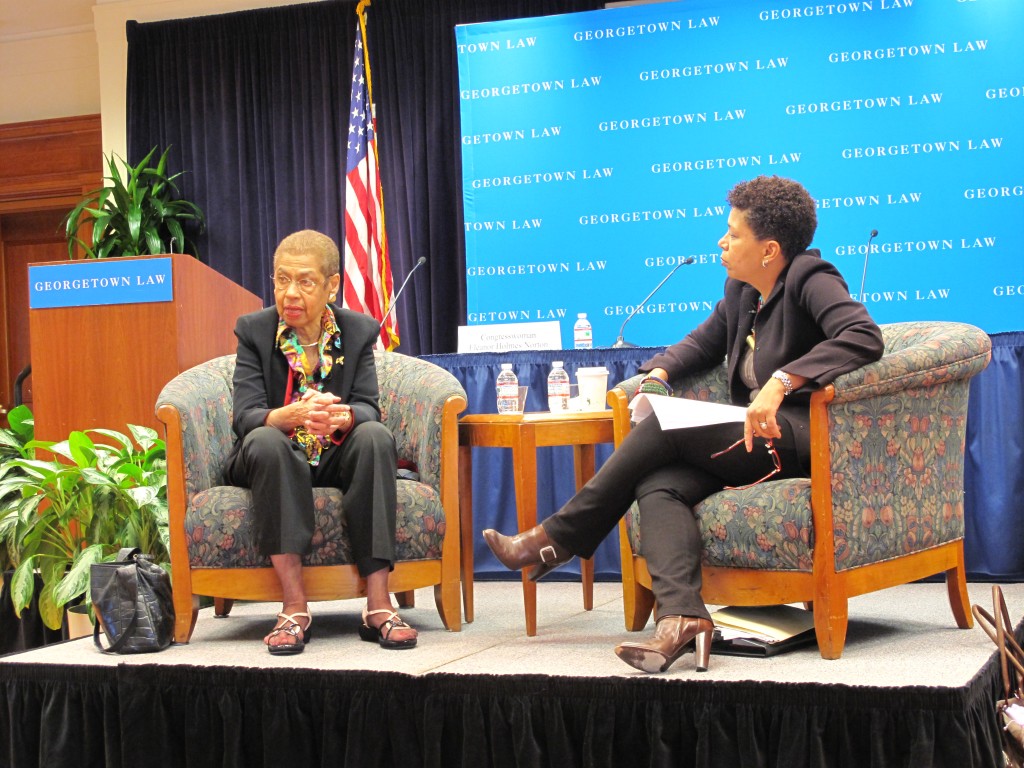Today I talked about street harassment with Delegate Eleanor Holmes Norton (DC) and NPR’s Michel Martin, host of the afternoon show Tell Me More.
How did I get to have a conversation about street harassment with such amazing women?
Well, I had the privilege of attending a conference at Georgetown Law Center that commemorates the 20 years since Professor Anita Hill testified to the Senate Judiciary Committee about how Clarence Thomas sexually harassed her when she worked for him. Her testimony was part of his confirmation hearings for the U.S. Supreme Court. The Senators treated her abominably, and Thomas was appointed as a Justice.
Working women across the nation identified with what Hill said and seeing her talk about something so personal and taboo on live television opened up the floodgates.

Women started sharing their sexual harassment stories too. Hill’s testimony ultimately changed how we think about sexual harassment and it was a pivotal moment in our nation’s history. Plus, the way the men in the Senate treated Hill led women to vote women candidates into political office in numbers that have never been matched.
Today at the conference, law professors, media experts, and feminist activists talked about where we are today with regards to workplace sexual harassment and the impact the hearings has had on race and gender in our society. Hill was the closing speaker and it was an honor to hear from her.
But this post focuses on my conversation with Delegate Norton and Ms. Martin.
In the mid-afternoon, Martin sat down with Norton and asked her questions about what the hearing was like from her perspective as a new Congresswoman and as the former head of the Equal Employment Opportunities Commission (EEOC) who helped draft the original workplace sexual harassment policies. Martin was a white house correspondent at the time of the hearing and she shared a bit about her perspective. Both women provided fascinating insight into a national event I did not know was occurring at the time (I was eight years old) but one that paved the way for my anti-street harassment activism and the work I do at AAUW on sexual harassment in schools and the workplace.
After their illuminating conversation, there was time for questions from the audience. Without formulating my thoughts, I jumped up, amazed to have an opportunity to ask them their thoughts on applying lessons learned from workplace sexual harassment to current efforts around street harassment. I was not my most articulate and flubbed a bit, but I got into a grove during some of my responses back to them.
Norton spoke first. It quickly became clear she didn’t understand what I meant by “sexual harassment that happens in public places” and so I had to explain street harassment to this long-time feminist and leader in the sexual harassment movement. It reminded me just how normalized street harassment is and/or how rarely it must happen to someone of Norton’s privileged position if she did not know much about it despite working on sexual harassment issues, often in a leadership position, since the mid-1970s.
Martin, on the other hand, knew exactly what I was talking about and helped me explain it to Norton. In fact, Martin helped everyone in the room understand the issue vividly by sharing a story. She said when she was a white house correspondent she regularly plotted her route through Lafayette Park based on how many potential harassers she saw. She’d forgotten about having to do that, she said, but today her memory of that experience seemed to help her understand why ending street harassment matters.
While I didn’t mean for Norton to solely talk about how to use laws to address street harassment, once she knew what I was talking about, that is where her mind went because of her legal background. She said verbal comments are protected by The First Amendment (freedom of speech) and it would be difficult to prosecute strangers. A few legal scholars have written compelling articles about the law and street harassment and The First Amendment barrier can be overcome. Fighting words, hate crimes, intention to inflict emotional distress: none of these are protected by The First Amendment and a lot of street harassment could be considered one or all of those. (I wasn’t fast enough on my feet to respond with this information but Martin noted the fighting words exception and compared men calling a woman “bitch” to using racial slurs.)
Further, why is it yelling, “Fire” in a building unprotected by the First Amendment (and illegal), but a middle-age man is allowed to walk behind a college-age young woman and say, “This is what I like right here, these are the kinds of girls I want to f*ck right here. This ones’ gonna get it” and then threaten to rape her and pull down her shirt before two bystanders intervened? That’s protected by the First Amendment? By the way, even with two witnesses, the police said nothing “serious” had happened and the poor student had to continue on to class and take an exam.
That is not right.
Additionally, Independence and Columbia, Missouri, passed a city ordinance against harassing pedestrians and bicyclists from cars and Los Angeles passed one against motorists harassing pedestrians. It can be done if we want it to be done. (Again, I didn’t think fast enough to respond with this information.)
I don’t think a law would be the most effective way to stop street harassment and I know there are a lot of valid concerns with using laws to regulate street harassment and racial-profiling-happy police to enforce them. But I also think a carefully worded law could help change social attitudes and it may give some people cause to pause before harassing.
When I mentioned groping in my definition of street harassment, Norton said that was already illegal and women should report gropers. Then she stated how lots of groping occurs in “Arab countries” where women face so much oppression. I was taken aback. Yes, groping is a big problem in countries like Egypt and Yemen but, as I discuss in my book and as stories submitted to my blog regularly show, it also is in countries like Japan, Italy, and, PS, the USA! Street harassment is a global problem.
She concluded by saying she doesn’t think there can be a law to regulate street harassment, but she thinks consciousness-raising is the key and that things like SlutWalks are best because they tell men that “the behaviors are forbidden.”
While I appreciate SlutWalks (and spoke at SlutWalk DC) and love consciousness-raising tactics, they can’t be the only solution! So many street harassers are grown men who harass teenage girls. They know their behavior is wrong and that it is, in Norton’s words, “forbidden.” They are not held accountable; there are no consequences, so they continue to harass. SlutWalks alone will not change that.
I didn’t want to take up more time because others had questions but WOW was there a lot I would have liked to say.
Fortunately, Martin really did seem to understand what I was talking about and she said she’d be interested in having me on her show. I’m mailing her a copy of my book tomorrow and I hope she will decide to have me (and possibly some other local DC street harassment activists) on her show.
And if am on her show, I hope Norton will listen so she can learn more about street harassment. More importantly, I hope one day Norton can have time to speak to youth in her community who face street harassment daily so she can understand its prevalence and impact. If she understood, I think she’d be a big ally. After all, she’s been a leader on the issue of sexual harassment for nearly 40 years.
With the growing number of commemorations of the Hill-Thomas hearings (I’ll attend another conference about workplace sexual harassment with Hill as the keynote at Hunter College on October 15), I hope anti-street harassment activists can find similar opportunities to draw attention to street harassment and hopefully inspire major feminist leaders to learn more and address it, too.

